-Project update-
Following public exhibition of the project between October and December 2022, Veolia received all of the submissions made to the Department of Planning, Housing, and Infrastructure (DPHI, previously DPE) about the project. There were over 600 submissions made in total.
Thank you to everyone who took the time to engage with us as part of the public exhibition, as well as make a submission. The feedback received has been varied, with key themes of air quality, farming, health and traffic.
We have been reviewing all submissions in detail, and are working to respond to them as part of our response to submissions report. To ensure we fully address the matters raised, and provide clarity in areas where more detail has been requested, we are taking the time necessary to complete this report.
Additional studies are being undertaken and we continue to seek clarity from some submissions and take on feedback. We are currently in the process of completing the response to submissions report.
We will continue to keep the community updated on timelines as we progress.
A facility that will create jobs, support regional
communities and generate energy
Veolia is proposing the next phase in sustainable development at Woodlawn, using state of the art technology to build an Advanced Energy Recovery Centre (ARC). The ARC will take waste that cannot be recycled and turn it into energy, producing enough electricity to power 40,000 homes a year.
Building on the existing Woodlawn Eco Precinct in Tarago, the new facility will be an important part of Veolia’s continued investment in regional New South Wales (NSW), that will create hundreds of jobs, drive economic growth, and support Australia’s environmental shift towards a circular economy.
As part of this ongoing commitment to local people and more broadly to our planet, the next phase of sustainable development for the Woodlawn Eco Precinct is to adopt Energy from Waste technology, so that we can eventually move away from landfilling.
Energy from Waste technology is proven worldwide and it is recognised as safe by regulators and relevant health organisations. It is also the policy of the Australian and NSW to adopt such practices to reduce emissions and improve its management of wastes - a necessary step in achieving climate-related goals of 80% recovery rate by 2030.
The ARC will divert up to 380,000 tonnes of waste from landfill every year (enough to fill 172 Olympic swimming pools), and turn it into energy using Energy from Waste technology. As a world leader in sustainable waste management solutions, Veolia owns and operates more than 65 energy recovery facilities globally, and has the expertise to meet the strict environmental standards set by NSW’s Environment Protection Authority.
300 jobs will be created during construction and 40 jobs will be created during operation.
If you look at the waste hierarchy diagram below, you can see that after first avoiding waste, reusing it and then recycling it, the recovery of energy should be utilised as the preferred treatment option. Landfill is the least preferred waste management option because landfilling doesn't allow recovery of the material disposed of. Reducing landfill waste reduces methane, a greenhouse gas that is 25 times more impactful on the environment that carbon dioxide.
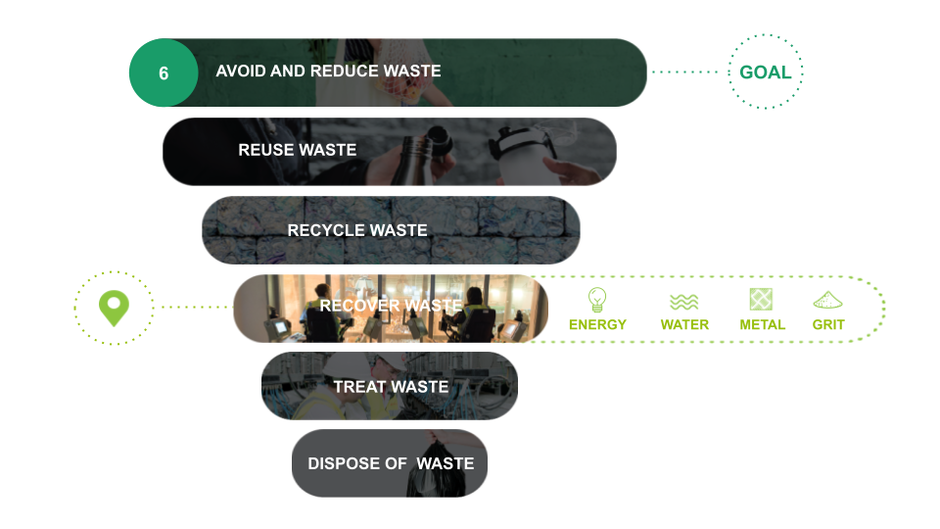
Energy recovery is an important source of renewable, sustainable energy and a vital link in the waste management chain. Waste reduction, recycling and materials recovery operations are the first priority, however once we have optimised these operations, it makes sense to recover energy from the remaining waste where possible. Energy recovery facilities reduce the use of fossil fuels, cut emissions of greenhouse gases and reduce dependence on landfill.
Energy recovery from waste works similarly to conventional coal or gas combustion, where steam is made from the heat and then used to run a turbine to produce electricity. Instead of using fossil fuels, energy-from-waste technology has been adapted and updated to use non-recyclable waste materials. Three tonnes of waste replaces one tonne of coal, and is 50% biomass, delivering a low-carbon energy solution, whilst reducing the need for landfill. Veolia has the expertise to safely deliver the technology.
In addition to the energy produced, three other materials are recovered during the process:
- Bottom ash: non-combustible material such as stones, grit, glass, and rocks. This can be recycled into aggregates for use in the construction industry
- Air pollution-control residues: fine dust is filtered, captured, and manged on site
- Ferrous and non-ferrous metals are recovered from the bottom ash. The materials are collected and recycled into new metal items
As part of its Environmental Impact Statement (EIS), the ARC project underwent a series of health, safety, social, and environmental impact assessments. Two key assessments are known as the Air Quality Impact Assessment, and the Human Health Risk Assessment.
The findings from both of these assessments reflected that there would be no significant changes to air quality, and no impact on health with the introduction and operation of the Woodlawn ARC.
Hear from the independent technical experts who conducted these assessments below.
Air Quality Impact Assessment overview and results
Human Health Risk Assessment overview and results
The Woodlawn Eco Precinct, where the Advanced Energy Recovery Centre (ARC) is proposed, is situated within an agricultural region. Located within the town of Tarago NSW, the area surrounding the facility includes land used for livestock grazing and a range of crops. Veolia has taken precaution to ensure that thorough modelling and assessments have been undertaken with these considerations in mind.
The independently conducted Human Health Risk Assessment accounts for any impacts to people, livestock and crops. This is particularly important for communities with farming livelihoods, and where strict regulations are imposed by relevant food and health regulators.
Goods produced in the area include, but are not limited to, fruit, vegetables, grain, milk, eggs, and meat. With this context, assessment was undertaken to determine potential impacts on health and quality of produce as a result of air emissions from the ARC.
If approved, the facility would be subject to strict regulation by the NSW Environmental Protection Authority (EPA), who will set the ARC's operating licence and will rigorously monitor ongoing operations. The ARC will have continuous emission monitoring systems in place, which will automatically react to flue gas conditions, and the results of which will be closely scrutinised by the EPA.
Hear from Dr Jackie Wright, the independent expert who conducted the Human Health Risk Assessment, in the 'Hear from the experts' tab.
Air emissions
The graph below shows the predicted maximum exposure to air emissions from the ARC.
The limit of 1 represents the maximum acceptable risk, or hazard index (HI), as outlined by the federal Environmental Health Standing Committee (enHealth). The graph shows that the maximum emission concentrations will be well within acceptable limits. A micro-view of the dioxin and furan levels has also been provided.
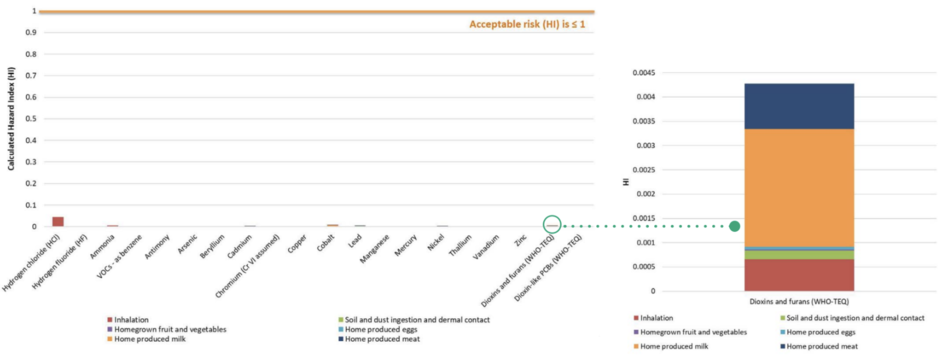
Crop quality
The assessment has shown that there would be no measurable changes to soil quality as a result of emissions, nor would the project change existing soil conditions or water quality.
The assessment looked at both homegrown food and the commercial sale of crops and produce grown in the region, which are held to strict health standards under the Food Standards Code. Results of this assessment determined that the maximum predicted concentrations from emissions in local produce would be well below limits prescribed by the Food Standards Code. In addition, farms which have organic farming certification would not be impacted by the ARC.
Produce
The graph below shows the European Union's allowed concentration levels, compared to the concentration levels as a result of the ARC.
The blue bars represent the European Union’s maximum (safe) levels in food, which have been adopted for the proposal in the absence of Australian-specific regulation.
The orange represents maximum potential ARC concentration levels, showing that they will be well within safe limits.
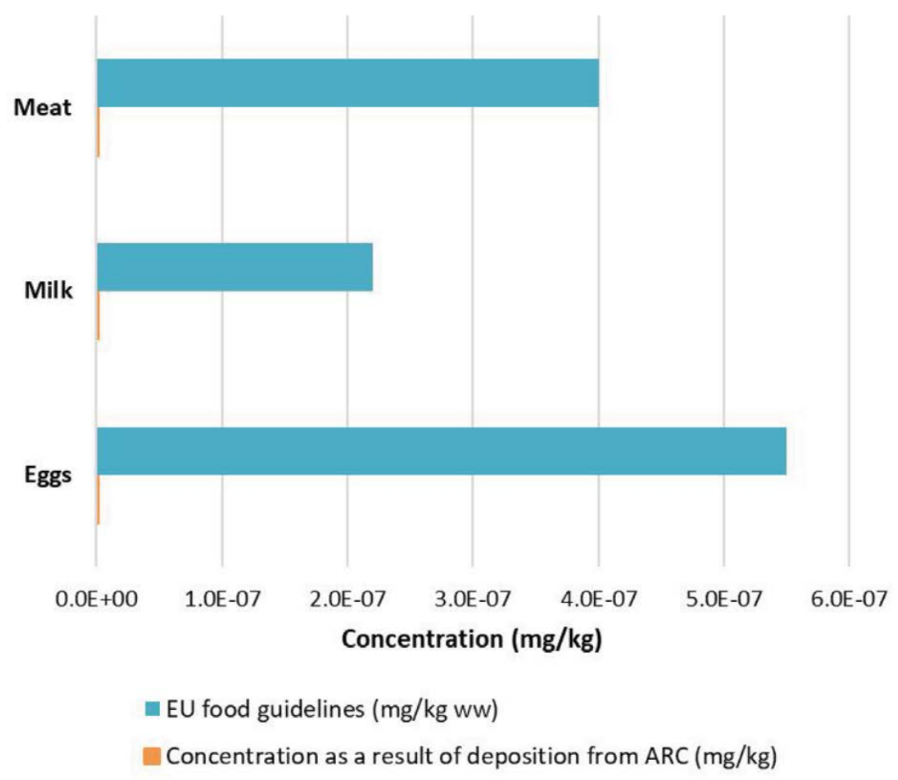
Grain products
The graph below shows how concentration levels as a result of the ARC (in red) would compare to existing concentrations and Food Standards Code limits. It can be seen that concentration levels from the ARC are so low that they are barely detectable on the graph, and are well below both safe limits and current average concentrations.
The orange bars represent current average concentrations found in cereal products in Australia (before the introduction of the ARC).
The purple bars represent limits prescribed by the Food Standards Code, for the concentrations which have regulation.
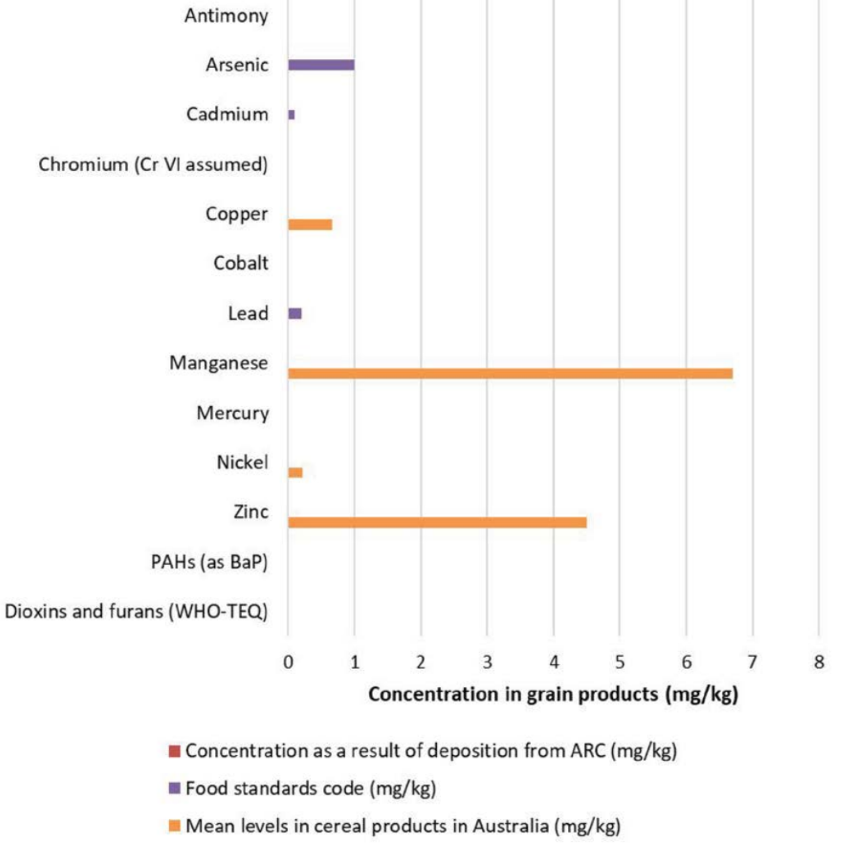
Soil quality
The impact on soil quality of the surrounding landscape and farmland was assessed, and it was found that emissions from the ARC will not be detectable in soil.
The assessment was conducted using highly conservative assumptions, such as modelling for a theoretical 70-year scenario (which would surpass the expected lifespan of the facility), and that there would be no top soil, fertiliser, or soil conditioner (which would reduce concentrations of chemicals in surface soil) used in this time span.
Results show that emissions from the ARC will be so negligible that they would not be detectable in soil, and that the maximum predicted chemical levels in the soil will be well below soil guidelines, for both residential and recreational use.
Water quality
The Human Health Risk Assessment also focused on the quality of local drinking and recreational water in Tarago and surrounding areas. Due to the rural location, many properties source their water from rainwater tanks and groundwater. The assessment shows that predicted water concentrations in tanks as a result of emissions from the ARC will be well within drinking water guidelines.
This means that water will be safe for both direct consumption by drinking and for use on farms.
The below graph shows the maximum concentrations in rainwater tanks from ARC emissions as a percentage of the Australian Drinking Water Guideline. The graph shows that concentrations from the ARC are well within safe drinking water limits for human health. In fact, the concentrations are predicted to be so low that they would not even be detectable using the best available analysis technology.
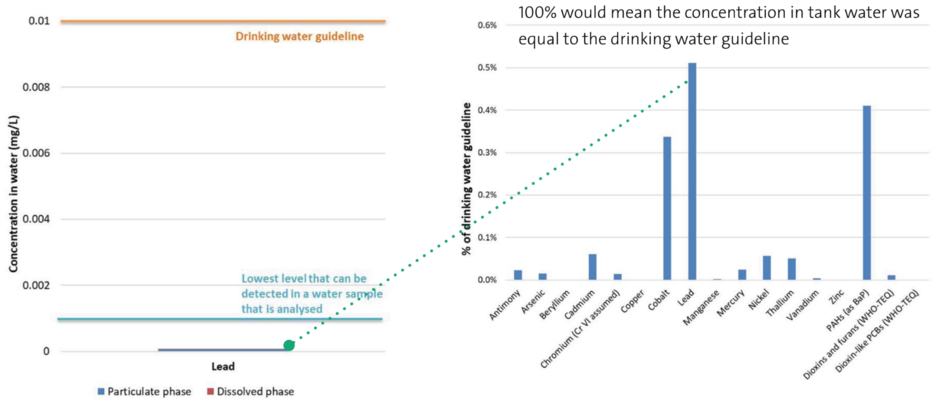
-Frequently asked questions-
View our full list of frequently asked questions below.
-Get in contact-
Sign up to our mailing list to stay updated with the project!
If you would like to speak with our team about the project please get in touch:
Email [email protected]
Write to PO Box 171 Granville NSW 1830
Call 1800 313 096
For media and press enquiries contact:
Valeria Cheglov, Head of Communications and Public Policy | [email protected]


